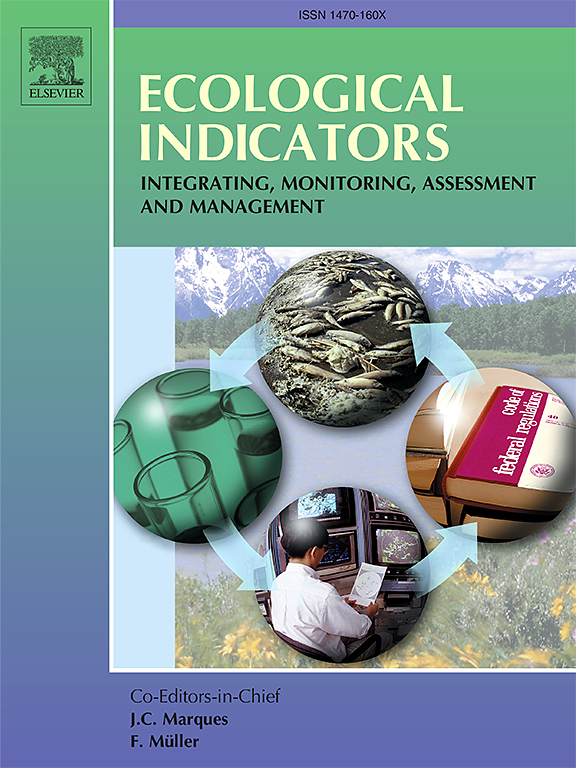基于Sentinel-1/2影像的若尔盖沼泽优势植物群落制图及其植被恢复意义
IF 7
2区 环境科学与生态学
Q1 ENVIRONMENTAL SCIENCES
引用次数: 0
摘要
若尔盖沼泽在人为排水和全球气候变化的双重影响下,经历了不同程度的退化。现有研究通过卫星遥感获得了若尔盖沼泽退化面积的分布和变化数据;然而,对组成植物群落的详细鉴定尚未开展。本研究以Sentinel-1/2影像和数字高程模型(digital elevation model, DEM)为数据源,建立了植被结实和枯干季节的中位数复合影像。在此基础上,应用随机森林(RF)算法对若尔盖沼泽退化区以矮嵩草(Kobresia)、苔草(Carex)和灰草(Blysmus)为主的3个植物群落进行了识别。生成的地图总体精度达到89.2%。最后,基于训练好的射频模型重构决策规则。结果表明,草苔属植物可通过果期影像特征进行鉴定,而其他两种植物则需要双相影像特征进行鉴定,其中矮嵩草属植物的鉴定难度较大。这可能与不同植被群落的需水量有关:矮嵩草更耐旱,经常与其他高原草本植物混合生长。本研究在若尔盖沼泽退化区生成了3个优势植物群落,为揭示若尔盖沼泽退化现状及其恢复潜力提供了新的参考方法和数据支持。本文章由计算机程序翻译,如有差异,请以英文原文为准。
Mapping dominant plant communities in the degraded Zoige swamp using Sentinel-1/2 imagery and its implications for vegetation restoration
Zoige swamp has experienced varying degrees of degradation due to human-driven drainage and global climate change. Through satellite remote sensing, existing studies have obtained data on the distribution and changes in area of degraded Zoige swamp; however, the detailed identification of constituent plant communities has not been conducted. In this study, we used Sentinel-1/2 imagery and digital elevation model (DEM) as the data sources to create median composite images for the fruiting and withering seasons of vegetation. Then, we applied the random forest (RF) algorithm to identify three plant communities dominated by Kobresia, Carex, and Blysmus in the degraded Zoige swamp. The generated map achieved an overall accuracy of 89.2%. Finally, we reconstructed the decision rules based on the trained RF model. The results showed that Carex could be identified through the image characteristics of the fruiting season, whereas the other two communities required dual-phase image features, wherein the identification of Kobresia was particularly challenging. This may be related to the differing water demands of vegetation communities: Kobresia is more drought-tolerant and often mixed with other plateau-based herbaceous plants. This study generated three dominant plant communities in the degraded Zoige swamp, providing new reference methods and data-based support to reveal the current degradation status and its restoration potential.
求助全文
通过发布文献求助,成功后即可免费获取论文全文。
去求助
来源期刊

Ecological Indicators
环境科学-环境科学
CiteScore
11.80
自引率
8.70%
发文量
1163
审稿时长
78 days
期刊介绍:
The ultimate aim of Ecological Indicators is to integrate the monitoring and assessment of ecological and environmental indicators with management practices. The journal provides a forum for the discussion of the applied scientific development and review of traditional indicator approaches as well as for theoretical, modelling and quantitative applications such as index development. Research into the following areas will be published.
• All aspects of ecological and environmental indicators and indices.
• New indicators, and new approaches and methods for indicator development, testing and use.
• Development and modelling of indices, e.g. application of indicator suites across multiple scales and resources.
• Analysis and research of resource, system- and scale-specific indicators.
• Methods for integration of social and other valuation metrics for the production of scientifically rigorous and politically-relevant assessments using indicator-based monitoring and assessment programs.
• How research indicators can be transformed into direct application for management purposes.
• Broader assessment objectives and methods, e.g. biodiversity, biological integrity, and sustainability, through the use of indicators.
• Resource-specific indicators such as landscape, agroecosystems, forests, wetlands, etc.
 求助内容:
求助内容: 应助结果提醒方式:
应助结果提醒方式:


